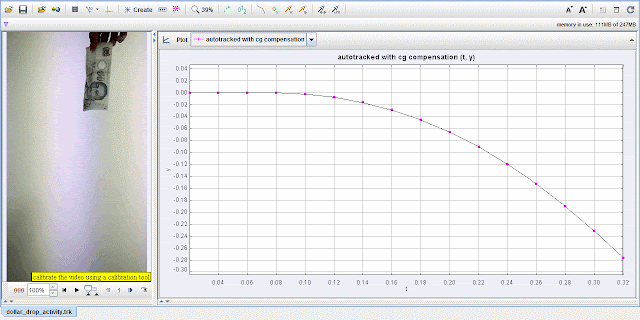

About
For Teachers
Credits
Author: Leong Tze Kwang
Contact: leongtzekwang@gmail.com

To show that dollar drop has negligible air resistance for the 1st 0.3 second of the drop and can be used to determine human reaction time.
Document Brief: Title: "Tracker Reaction Time: 50 Dollars Note Drop"
This document explores the concept of human reaction time through the 50-dollar note drop experiment. By analyzing the time taken to catch the falling note, the study provides insights into neural response and reflexes.
Study Guide:
Objective: Measure and analyze reaction time using a simple and practical experiment involving a falling 50-dollar note.
Key Concepts:
-
Reaction Time:
-
The interval between the presentation of a stimulus (release of the note) and the response (catching it).
-
-
Free Fall:
-
The note accelerates under gravity () as it falls.
-
-
Neural Response:
-
Reaction time reflects the efficiency of sensory input, neural processing, and motor output.
-
Experiment Overview:
-
Setup: Hold a 50-dollar note vertically between the thumb and forefinger of a participant's hand. Ensure the hand is positioned to catch the note as it falls.
-
Procedure:
-
Without warning, release the note and measure the time or distance it falls before being caught.
-
Use the equation to calculate reaction time, where is the distance fallen and is the acceleration due to gravity.
-
-
Observation Points:
-
The distance the note falls before being caught.
-
Variation in reaction times among different participants.
-
Questions to Consider:
-
How does reaction time vary among individuals?
-
Answer: Reaction time depends on factors like age, alertness, and practice. Younger individuals and those with faster reflexes tend to have shorter reaction times.
-
-
How is reaction time calculated in this experiment?
-
Answer: By measuring the distance and using the equation .
-
-
What factors can influence reaction time?
-
Answer: Distractions, fatigue, and anticipation can affect the outcome.
-
Applications:
-
Understanding neural response times in humans.
-
Testing reflexes in educational or medical settings.
-
Highlighting the importance of reaction time in activities like driving and sports.
FAQ:
-
Why use a 50-dollar note? The note’s dimensions and weight make it ideal for this simple and practical demonstration.
-
What does the experiment demonstrate? It showcases human reaction time and the factors influencing it, such as alertness and focus.
-
Can this be applied to real-life scenarios? Yes, reaction time is critical in many daily activities, including driving, sports, and emergency responses.
-
How accurate is the measurement? While not highly precise, the experiment provides a good approximation of reaction time, especially when repeated and averaged.
-
What variations can be introduced? Using different objects or testing under varied conditions (e.g., distractions or different hand positions) can provide additional insights.
- Details
- Written by Kimkia
- Parent Category: 01 Foundations of Physics
- Category: 01 Measurements
- Hits: 7494
